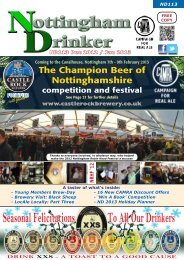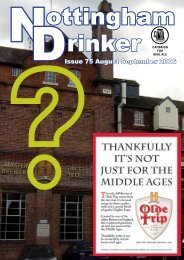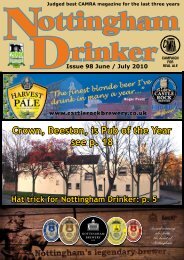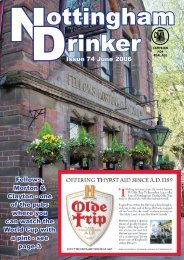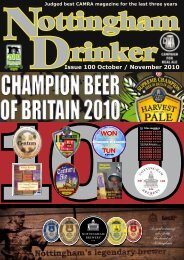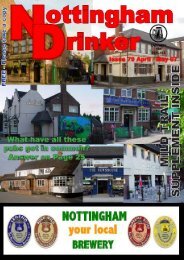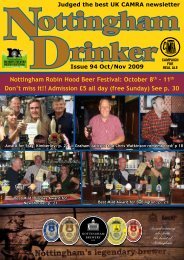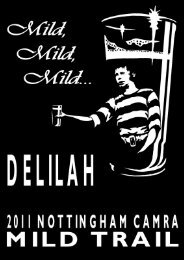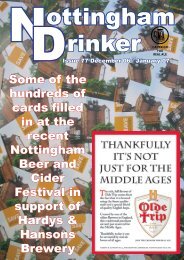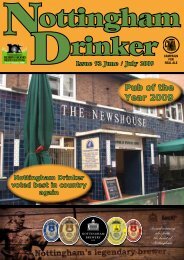New brewery and visitor centre for Belvoir - Nottingham CAMRA
New brewery and visitor centre for Belvoir - Nottingham CAMRA
New brewery and visitor centre for Belvoir - Nottingham CAMRA
Create successful ePaper yourself
Turn your PDF publications into a flip-book with our unique Google optimized e-Paper software.
Stout <strong>and</strong> Porter Stroll<br />
<strong>Nottingham</strong> <strong>CAMRA</strong><br />
Stout & Porter<br />
troll<br />
8 - 29th<br />
March 2008<br />
Stouts <strong>and</strong> Porters – a history<br />
Porter was a London style that turned the brewing industry<br />
upside down early in the 18th century. It was a dark brown<br />
beer – 19th-century versions became jet black – that was<br />
originally a blend of brown ale, pale ale <strong>and</strong> ‘stale’ or wellmatured<br />
ale. It acquired the name Porter as a result of its<br />
popularity among London’s workers who carried goods<br />
around the City. There was no mechanised transport <strong>and</strong><br />
horses were expensive so goods <strong>and</strong> supplies were simply<br />
carried around by these porters. The strongest versions of<br />
Porter were known as Stout Porter, reduced over the years to<br />
simply Stout. Such vast quantities of Porter <strong>and</strong> Stout flooded<br />
into Irel<strong>and</strong> from London <strong>and</strong> Bristol that a Dublin brewer<br />
named Arthur Guinness decided to fashion his own<br />
interpretation of the style. The beers were strong – 6% <strong>for</strong><br />
Porter, 7% or 8% <strong>for</strong> Stout. Guinness in Dublin blended some<br />
unmalted roasted barley <strong>and</strong> in so doing produced a style<br />
known as Dry Irish Stout. Restrictions on making roasted malts<br />
in Britain during World War One led to the demise of Porter<br />
<strong>and</strong> Stout <strong>and</strong> left the market to the Irish. In recent years,<br />
smaller craft brewers in Britain have rekindled an interest in the<br />
style, though in keeping with modern drinking habits,<br />
strengths have been reduced. Look <strong>for</strong> profound dark <strong>and</strong><br />
roasted malt character with raisin <strong>and</strong> sultana fruit, espresso or<br />
cappuccino coffee, liquorice <strong>and</strong> molasses, all underscored by<br />
hefty hop bitterness. Porters are complex in flavour, range<br />
from 4% to 6.5% <strong>and</strong> are typically black or dark brown; the<br />
darkness comes from the use of dark malts unlike stouts which<br />
use roasted malted barley. Stouts can be dry or sweet <strong>and</strong><br />
range from 4% to 8% ABV.<br />
www.nottinghamcamra.org February/ March 08 15



